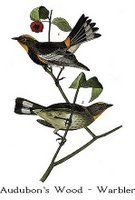Make that 200?
 OCT. 29, GRINDSTONE PARK, sunny, 75—On an afternoon visit to Grindstone, my home park, I gradually realized that just about the only birds left in Missouri's woods are core year-round residents and—even more frightening—winter visitors like the yellow-rumped warbler and white-crowned sparrow. Summering birds and migrants are gone.
OCT. 29, GRINDSTONE PARK, sunny, 75—On an afternoon visit to Grindstone, my home park, I gradually realized that just about the only birds left in Missouri's woods are core year-round residents and—even more frightening—winter visitors like the yellow-rumped warbler and white-crowned sparrow. Summering birds and migrants are gone.I saw enough dominance on my list by old familiars to make me think I was back at the beginning of the year: juncos, goldfinches and chickadees, downy, hairy, and red-bellied woodpeckers, cardinals and bluejays.
Fortunately the weather was so warm and perfect I didn't mind all the critical analysis churning in my birder superego. Namely: I didn't work hard enough to see spring migrants; bicycle trip preparations burned up summer weekends and kept my songbird numbers down; and not quite making it to the Rio Grande meant no subtropical birds on my list.
Now I see three possibilities for reaching 300: a lottery victory enabling me to crisscross the country for the next two months (I could even reach 400!), a job offer from the Gulf coast of Texas, or closer to home, convincing one of our local superbirders to adopt me.

